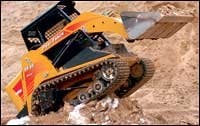On a chilly afternoon some six weeks ago, we watched Brad Lemke, director of product development for ASV, as he spared no horsepower in demonstrating the aggressive performance of the company's new SR-80 Posi-Track loader.
Working the new machine in a remote area of ASV's extensive proving grounds — near its Grand Rapids, Minn., factory, Lemke excavated deeply into the site's heavy sandy clay and ran the new tractor up, down and across the site's imposing grades and rutted surfaces. Then, on a concrete test pad, he repeatedly drove the new model at top speed over a 4×4 timber placed across one track's path. We were impressed at how calmly the SR-80's new four-bogie undercarriage rippled across this impediment.
"The SR-Series is the most significant model introduction in ASV's history," says Lemke. "Just about every idea, wish and want we as a manufacturer have had in 20-plus years of building rubber-track loaders is reflected in this new design. We've invested more in manufacturing tooling for these machines than we invested in all our previous models — combined. Not counting nuts and bolts, there are, literally, only five or so part numbers that are common with our existing models."
The new series, which includes the 80-hp flagship model, the SR-80, and a 70-hp companion model, the SR-70, was three years in development, says Lemke. And although the new machines don't replace any of the company's current nine models, the technology they embody, he says, eventually will work its way through the entire line. That transfer of technology likely will include the stellar feature of the SR-Series — its new "single-rail" undercarriage.
ASV has been building rubber-track vehicles since the early-1980s, and the hallmark feature of its loaders has always been a suspended undercarriage that flexes as it encounters obstacles in its path. The new SR-Series undercarriage, which ASV calls a "single-rail" design, is the company's fourth-generation concept, and according to Lemke, the best yet.
Similar to the preceding undercarriage generations, the single-rail system retains the essentials of ASV's undercarriage design: proprietary rubber tracks that contain no steel; multiple wheels to spread the tractor's weight evenly over the tracks; torsion axles to provide the desired suspension qualities; and a roller-cage sprocket.
That said, however, the new single-rail system represents a significant departure in overall design from its predecessors. We've included a couple of computer-generated illustrations from ASV's engineering files to help you understand the fundamentals of the single-rail design,





